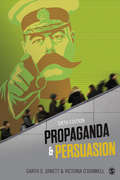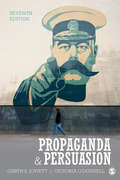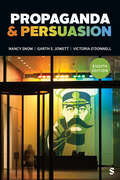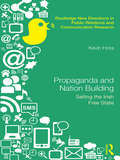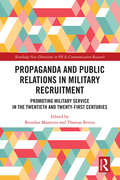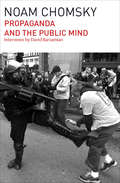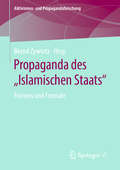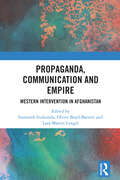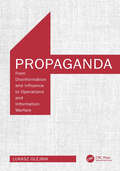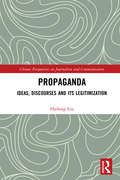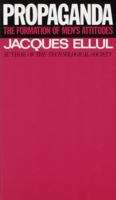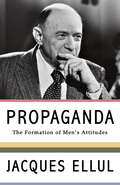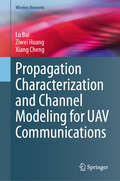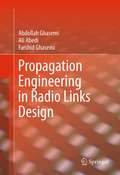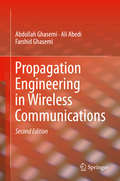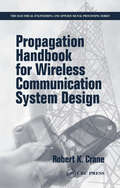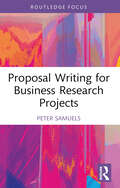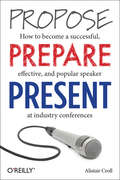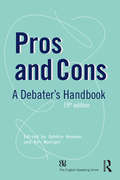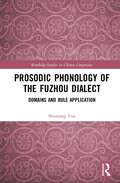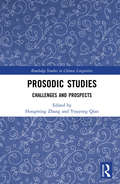- Table View
- List View
Propaganda & Persuasion
by Dr Garth S. Jowett Victoria J. O'DonnellPropaganda and Persuasion, Sixth Edition, by Garth S. Jowett and Victoria O’Donnell, is the only book of its kind to comprehensively cover the history of propaganda and offer insightful definitions and methods to analyze it. Fascinating examples, from ancient times to present day, facilitate a solid understanding of what propaganda is. The book includes current research in propaganda and persuasion, discusses the use of propaganda in psychological warfare, and offers students a systematic approach to analyzing the propaganda and persuasion they will encounter in everyday life.
Propaganda & Persuasion
by Dr Garth S. Jowett Victoria J. O'DonnellReflecting the remarkable changes in the world of propaganda due to the increasing use of social media, this updated Seventh Edition provides a systematic introduction to the increasingly complex world of propaganda. Viewing propaganda as a form of communication, the authors help you understand information and persuasion so you can understand the characteristics of propaganda and how it works as a communication process. Providing provocative case studies and fascinating examples of the use of propaganda from ancient times up through the present day, Propaganda and Persuasion provides an original model that helps you analyze the instances of propaganda and persuasion you encounter in everyday life. New to the Seventh Edition: New coverage of social media as a disseminator of propaganda offers you an up-to-date perspective. The book’s four case studies have been updated and strengthened to demonstrate their relevance not only to past and contemporary culture, but also to the study of propaganda campaigns. New coverage of how a propaganda case study can be structured to reveal the components of a campaign allows you to compare strengths and weaknesses across different types of campaigns and evaluate the relative success of various propaganda strategies. Updated research on persuasion and expanded coverage of collective memory as it appears in new memorials and monuments enhances the presentation. Current examples of propaganda, especially the ways it is disseminated via the Internet, deepen your understanding. New illustrations and photos add a unique visual dimension that helps you conceptualize methods of persuasion and propaganda.
Propaganda & Persuasion
by Dr Garth S. Jowett Victoria J. O'DonnellReflecting the remarkable changes in the world of propaganda due to the increasing use of social media, this updated Seventh Edition provides a systematic introduction to the increasingly complex world of propaganda. Viewing propaganda as a form of communication, the authors help you understand information and persuasion so you can understand the characteristics of propaganda and how it works as a communication process. Providing provocative case studies and fascinating examples of the use of propaganda from ancient times up through the present day, Propaganda and Persuasion provides an original model that helps you analyze the instances of propaganda and persuasion you encounter in everyday life. New to the Seventh Edition: New coverage of social media as a disseminator of propaganda offers you an up-to-date perspective. The book’s four case studies have been updated and strengthened to demonstrate their relevance not only to past and contemporary culture, but also to the study of propaganda campaigns. New coverage of how a propaganda case study can be structured to reveal the components of a campaign allows you to compare strengths and weaknesses across different types of campaigns and evaluate the relative success of various propaganda strategies. Updated research on persuasion and expanded coverage of collective memory as it appears in new memorials and monuments enhances the presentation. Current examples of propaganda, especially the ways it is disseminated via the Internet, deepen your understanding. New illustrations and photos add a unique visual dimension that helps you conceptualize methods of persuasion and propaganda.
Propaganda & Persuasion
by Nancy Snow Garth S. Jowett Victoria O′DonnellPropaganda and Persuasion, Eighth Edition offers a comprehensive history of propaganda and introduces the tools and concepts used to analyze it. New author Nancy Snow ushers in fresh perspectives, experience, and insight as one of the foremost scholars in propaganda studies to further augment the ideas, concepts, and analytical framework introduced by original authors Garth Jowett and Victoria O′Donnell. Ideal for courses in Persuasion, Propaganda, or Political Communication, this book draws on examples from ancient times to present-day issues, such as the impact of social media, to help students recognize, understand, and analyze the instances of propaganda and persuasion they encounter in an increasingly complex and digitalized world.
Propaganda & Persuasion
by Nancy Snow Garth S. Jowett Victoria O′DonnellPropaganda and Persuasion, Eighth Edition offers a comprehensive history of propaganda and introduces the tools and concepts used to analyze it. New author Nancy Snow ushers in fresh perspectives, experience, and insight as one of the foremost scholars in propaganda studies to further augment the ideas, concepts, and analytical framework introduced by original authors Garth Jowett and Victoria O′Donnell. Ideal for courses in Persuasion, Propaganda, or Political Communication, this book draws on examples from ancient times to present-day issues, such as the impact of social media, to help students recognize, understand, and analyze the instances of propaganda and persuasion they encounter in an increasingly complex and digitalized world.
Propaganda and International Criminal Law: From Cognition to Criminality
by Predrag DojčinovićThis book addresses the conceptual and evidentiary issues relating to the treatment of propaganda in international criminal law. Bringing together an interdisciplinary range of scholars, researchers and legal practitioners from Africa, Australia, Europe and the United States, the book provides an in-depth analysis of the nature, position and role of the concept of propaganda in mass atrocity crimes trials. A sequel to the earlier Propaganda, War Crimes Trials and International Law: From Speakers’ Corner to War Crimes (Routledge, 2011) this book is the first to synthesize the knowledge, procedures and methods of international criminal law with the social cognitive sciences. Including a comprehensive overview of the most relevant case law, jurisprudence and scientific studies, the book also offers a series of practical insights and strategies for both academics and legal professionals. An invaluable resource for those working in the area of international criminal law, this book will also be of interest to academics, practitioners and students with relevant interests in legal theory, politics, linguistics and psychology.
Propaganda and Nation Building: Selling the Irish Free State (Routledge New Directions in PR & Communication Research)
by Kevin HoraThis book examines the origins of Ireland in its first independent incarnation, the Irish Free State (1922-1937). It explores how contemporary public relations and propaganda techniques were used to construct an identity for this new state – a state which after enduring seven years of insurrection and civil war, became one of the most stable democracies in Europe. This stability, the book argues, was constructed not solely through policies enacted by governments, but through the construction of a Gaelic, Catholic and Celtic national identity. By shifting the perspective to how nation building was communicated, it weaves an interdisciplinary narrative that initiates a new understanding of nation building - providing insights of increasing relevance in current world events. Avoiding a simplistic cause and effect history of public relations, the book examines the uses and effects of early public relations from a political and societal perspective and suggests that while governments were only modestly successful in their varied propaganda efforts, cumulatively they facilitated a transition from violence to peace. This will be of interest to researchers and advanced students with an interest in public relations, propaganda studies, nation building and Irish studies.
Propaganda and Public Relations in Military Recruitment: Promoting Military Service in the Twentieth and Twenty-First Centuries (Routledge New Directions in PR & Communication Research)
by Brendan Maartens; Thomas BivinsThis book represents the first international investigation of military recruitment advertising, public relations and propaganda. Comprised of eleven case studies that explore mobilisation work in Africa, the Americas, Asia and Europe, it covers more than a hundred years of recent history, with chapters on the First and Second World Wars, the Cold War, and the present day. The book explores such promotion in countries both large and small, and in times of both war and peace, with readers gaining an insight into the different strategies and tactics used to motivate men, women and occasionally even children to serve and fight in many parts of the world. Readers will also learn about the crucial but little-known role of commercial advertising, public relations and media professionals in the production and distribution of recruitment promotion. This book, the first of its kind to be published, will explore that role, and in the process address two questions that are central to studies of media and conflict: how do militaries encourage civilians to join up, and are they successful in doing so? It is a multi-disciplinary project intended for a diverse academic audience, including postgraduate students exploring aspects of war, propaganda and public opinion, and researchers working across the domains of history, communications studies, conflict studies, psychology, and philosophy.
Propaganda and the Public Mind: Conversations With Noam Chomsky And David Barsamian (Letras De Crítica Ser.)
by Noam Chomsky David BarsamianOne of our greatest political minds &“challenges us to think more independently and more deeply about the human consequences of power and privilege&” (Norman Solomon, author of Made Love, Got War). Renowned interviewer David Barsamian showcases his unique access to Chomsky&’s thinking on a number of topics of contemporary and historical import. Chomsky offers insights into the institutions that shape the public mind in the service of power and profit. In an interview conducted after the important November 1999 &“Battle in Seattle,&” Chomsky discusses prospects for building a movement to challenge corporate domination of the media, the environment, and even our private lives. Whether discussing US military escalation in Colombia, attacks on Social Security, or growing inequality worldwide, Chomsky shows how ordinary people, if they work together, have the power to make meaningful change. &“In Propaganda and the Public Mind, we have unique insight into Noam Chomsky&’s decades of penetrating analyses . . . drawn together in one slender volume by a brilliant radio interviewer, David Barsamian.&” ―Ben H. Bagdikian, Pulitzer Prize–winning journalist &“To anyone who wonders if ideas, information, and activism can make a profound difference in the twenty-first century, I say: &‘Read this book.&’&” ―Norman Solomon, author of The Habits of Highly Deceptive Media Praise for Noam Chomsky &“The conscience of the American people.&” —New Statesman &“Chomsky is a global phenomenon . . . perhaps the most widely read voice on foreign policy on the planet.&” —The New York Times Book Review &“There is no living political writer who has more radically changed how more people think in more parts of the world about political issues.&” ―Glenn Greenwald, journalist &“A truth-teller on an epic scale. I salute him.&” —John Pilger, journalist, writer, and filmmaker
Propaganda des „Islamischen Staats“: Formen und Formate (Aktivismus- und Propagandaforschung)
by Bernd ZywietzDie Propaganda der terroristischen Miliz „Islamischer Staat“ hat für Aufsehen gesorgt und die Debatte um das Internet und vor allem das „Social Web“ als Risikotechnologie oder Gefahrenraum mitbestimmt. Dabei setzt der IS auf ein breites Spektrum medialer und gestalterischer Formen und Formate einer globalen, digitalen Medienkultur, um ein internationales Publikum zu erreichen: Online-Videos, anashid (Lieder) und Computerspiele; Internet-Meme, Social Media Posting oder Selfies. Der Sammelband gibt Einblick in die Bandbreite dieser jihadistischen Kommunikate, ihrer Ausdrucks- und Darstellungsweisen und zeigt dabei Möglichkeiten der Einordnung und der Auseinandersetzung auf.
Propaganda, Communication and Empire: Western Intervention in Afghanistan
by Oliver Boyd-Barrett Sumanth Inukonda Lara Martin LengelThis volume interrogates the mediatized politics of western intervention in Afghanistan, to gain a deeper understanding of the occupation within the broader transition toward a multipolar global order.Accurate histories of western interventions and regional realities are often obscured or even eclipsed in the accounts of western mainstream media, which, if anything, tend to rue the withdrawals and lionize the suffering of returning troops. This volume investigates the state’s role in the dark underbelly of the shortsighted interventionist media narrative, as well as the dehumanizing portrayals of people living in the Afghanistan–Pakistan region. In its opening section, the book critically evaluates the narrative of the Global War on Terror, as well as the wars launched after 9/11 that destabilized the Middle East. The chapters in the following section contextualize developments in Afghanistan with a historical framework that will problematize linear narratives that are mobilized in support of interventions. The chapters in the final section re-present specific aspects of the geopolitical and humanitarian consequences that have eluded mainstream media workers, including journalists and Hollywood moviemakers.This book will be of interest to students of propaganda studies, media and communication studies, US foreign policy, and international relations.
Propaganda: From Disinformation and Influence to Operations and Information Warfare
by Lukasz OlejnikThe book is a modern primer on propaganda—aspects like disinformation, trolls, bots, information influence, psychological operations, information operations, and information warfare. Propaganda: From Disinformation and Influence to Operations and Information Warfare offers a contemporary model for thinking about the subject.The first two decades of the 21st century have brought qualitative and quantitative technological and societal changes, and the subject of information influence needs to be re-ordered. Now is the time.The book explains the origins of the meaning and phenomenon of propaganda—where it came from and how it has changed over the centuries. The book also covers modern methods, including artificial intelligence (AI) and advertising technologies. Legal, political, diplomatic, and military considerations ensure that the material is covered in depth.The book is recommended for security and cybersecurity professionals (both technical and non-technical), government officials, politicians, corporate executives, academics, and students of technical and social sciences. Adepts with an interest in the subject will read it with interest.
Propaganda: Ideas, Discourses and its Legitimization (Chinese Perspectives on Journalism and Communication)
by Hailong LiuPropaganda is subjective information primarily used to influence an audience and further a political agenda. In China, it has a long history but has been most effective in modern society. What exactly is propaganda? Why does it exist and why does the public tolerate it? The book answers these questions by tracing back to the emergence and development of integrated propaganda and scientific propaganda. On this basis it focuses on the emergence of propaganda concept in China, the establishment of Kuomintang and the Communist Party of China’s propaganda concept, intellectuals and propaganda, the debate on the propaganda concept in China after 1949 as well as the emergence of Propaganda 3.0 that coordinates integrated propaganda and scientific propaganda. Setting propaganda in the framework of modernity, the book explains how various groups have legitimatized propaganda since the 20th century. From a reasonable and neutral standpoint, the author describes the confrontation among various propaganda concepts and discourses, displaying a panorama of the mutual conflicts between nations and individuals, control and freedom, ideas and bodies. Not only will scholars and students studying journalism and communication find this book interesting, but professionals working in journalism, advertising, public relations and publicity will also find it engaging and enlightening.
Propaganda: The Basics (The Basics)
by Nathan CrickThis concise and accessible guide makes clear the ubiquity of propaganda so that readers can understand its function in all layers of society, for both good or for ill, and ultimately use it to make their own voice heard.Propaganda often appears as a paradoxical art: modern society is awash in propaganda and yet many deny consuming it. Using short, easy to understand examples drawn from politics, culture, and advertising from around the world, this book introduces readers to the basic theory, research, and techniques of propaganda from the American Revolution to the present day. It demystifies propaganda for the purpose of democratizing it, revealing it as a form of mass persuasion that is a necessary part of political culture and essential to promoting social movements, social reforms, political agendas, scientific ideas, and aesthetic tastes. The book emphasizes the creative aspect of propaganda while also stressing the need for critical media literacy and ethical judgment.Filling a major gap in the literature, this book is an essential read for students of persuasion, rhetoric, communication, journalism, advertising, and public relations. It is also ideal for anyone interested in the fundamental principles and tactical forms of propaganda and those approaching the subject for the first time.
Propaganda: The Formation of Men's Attitudes
by Jacques EllulJacques Ellul's view of propaganda and his approach to the study of propaganda are new. The principal difference between his thought edifice and most other literature on propaganda is that Ellul regards propaganda as a sociological phenomenon rather than as something made by certain people for certain purposes.
Propaganda: The Formation of Men's Attitudes
by Jacques EllulThis seminal study and critique of propaganda from one of the greatest French philosophers of the 20th century is as relevant today as when it was first published in 1962. Taking not only a psychological approach, but a sociological approach as well, Ellul&’s book outlines the taxonomy for propaganda, and ultimately, it&’s destructive nature towards democracy. Drawing from his own experiences fighting for the French resistance against the Vichy regime, Ellul offers a unique insight into the propaganda machine.
Propagation Characterization and Channel Modeling for UAV Communications (Wireless Networks)
by Xiang Cheng Ziwei Huang Lu BaiThis book focuses on the propagation characterization and channel modeling of Unmanned Aerial Vehicle (UAV) communications. Currently, there are no books that cover this specific topic. The authors fill in this void by elaborating accurate yet easy-to-use UAV channel models. The authors also present such topics as propagation characteristics of UAV communications, a time stationary regular-shaped geometry-based stochastic model (RS-GBSM) for UAV narrowband channels. It also introduces a time non-stationary RS-GBSM for UAV narrowband channels, a time non-stationary RS-GBSM for UAV wideband channels, a time-space non-stationary irregular-shaped geometry-based stochastic model (IS-GBSM) for UAV wideband channels and more. Finally, this book closes up with some promising directions, hoping to promote future research outcomes in the field of UAV channel modeling. As the UAV technology matures rapidly, UAV communications are shifting from military development to civilian and commercial sectors. The UAV communication is widely considered as a significant and indispensable component of wireless communications. It is well known that an accurate yet easy-to-use UAV channel model is the foundation of designing a proper UAV communication system and evaluating its performance. This book also provides valuable suggestions for the design of UAV communication systems by adequately presenting the UAV propagation characterization and channel modeling. This book is mainly written for researchers and professionals working in wireless communications. Advanced-level students majoring in computer science or electrical engineering may also find the content useful as a secondary textbook.
Propagation Engineering in Radio Links Design
by Farshid Ghasemi Abdollah Ghasemi Ali AbediThis book addresses propagation phenomena in satellite, radar, broadcasting, short range , trans-horizon and several recent modes of communications in radio links. Also, it includes some topics on antennas , radio noises and improvement techniques. The book provides the necessary basic matters, as well as experimental results and calculation procedures for radio link design.
Propagation Engineering in Wireless Communications
by Farshid Ghasemi Abdollah Ghasemi Ali AbediPropagation Engineering in Wireless Communications covers the basic principles needed for understanding of radiowaves propagation for common frequency bands used in radio-communications. This book includes descriptions of new achievements and new developements in propagation models for wireless communication. The book is intended to bridge the gap between the theoretical calculations and approaches to the applied procedures needed for radio links design in a proper manner. The authors intention is to emphasize propagation engineering by giving sufficient fundamental information and then going on to explain the use of basic principles together with technical achievements in this field.
Propagation Handbook for Wireless Communication System Design (Electrical Engineering & Applied Signal Processing Series)
by Robert K. CraneData and models for better systems designAtmospheric gases, building materials, the weather � The propagation of wireless communications signals depends upon a whole range of factors, any or all of which can have a significant impact on the quality of a signal. Data generated by careful measurement of signals propagating under various envir
Proposal Writing for Business Research Projects (Routledge Focus on Business and Management)
by Peter SamuelsThis book helps students with the initial phases of their business research project, offering a clear step-by-step approach from defining aims and research questions through to conducting literature reviews and writing a methodology. Features to aid learning include chapter objectives, plentiful real-life examples to demonstrate good practice, exercises to apply the concepts and further reading for proactive investigation. A self-contained guide to every stage of writing an effective business research proposal, this text should be recommended reading for all advanced undergraduate and postgraduate students studying Business Research Methods and embarking on a research project of their own.
Propose, Prepare, Present: How to become a successful, effective, and popular speaker at industry conferences
by Alistair CrollEvery year, tens of thousands of companies—from industry giants to aspiring upstarts—apply to speak at conferences. They pump millions of dollars into these events, hoping to find new customers, strengthen their brand, and meet new partners. Sadly, for most of them, things don’t go that way. Submitted topics aren’t chosen; when they are, they come across as tone-deaf sales pitches.What does it take to be chosen to speak—and to rock the mic when given the chance? This book takes you behind-the-scenes of the conference process, showing you how to submit, plan, and deliver a talk that matters. Event organizer Alistair Croll provides many examples based on his experience with a wide range of conferences, including O’Reilly’s Strata, Velocity, Web2Expo, and TOC Conferences.Learn 11 items that help your submission stand out—and 11 items that will get it tossedExplore the hurdles your proposal has to clear before it’s acceptedTailor your talk to a conference’s topics and themesDiscover why images work better than words in your slide deckAchieve your business goals by engaging the audience before, during, and after your talk"We’ve been running successful events worldwide for over a decade, and the simple truth is that the people who get chosen, and give great presentations, follow the rules in this book."--Gina Blaber, VP Conferences, O’Reilly Media
Pros and Cons: A Debaters Handbook
by Debbie Newman Ben WoolgarPros and Cons: A Debaters Handbook offers a unique and invaluable guide to the arguments both for and against over 140 current controversies and global issues. Since it was first published in 1896 the handbook has been regularly updated and this nineteenth edition includes new entries on topics such as the right to possess nuclear weapons, the bailing out of failing industries, the protection of indigenous languages and the torture of suspected terrorists. <P><P> Equal coverage is given to both sides of each debate in a dual column format which allows for easy comparison. Each entry also includes a list of related topics and suggestions for possible motions. <P><P> The introductory essay describes debating technique, covering the rules, structure and type of debate, and offering tips on how to become a successful speaker. The book is then divided into eight thematic sections, where specific subjects are covered individually.
Prosodic Phonology of the Fuzhou Dialect: Domains and Rule Application (Routledge Studies in Chinese Linguistics)
by Shuxiang YouProsodic Phonology of the Fuzhou Dialect: Domains and Rule Application is the first attempt to conduct a comprehensive analysis of the Fuzhou phonological system from the perspective of prosodic phonology. It addresses the following issues: What prosodic constituents exist in the Fuzhou dialect and what kinds of roles they play in the Fuzhou phonological system; how to define the domain formation of these prosodic constituents in the Fuzhou dialect; what kinds of Fuzhou phonological phenomena make crucial reference to these prosodic constituents as the domain of application; and what implications does the study of the Fuzhou phonological system have for the prosodic phonology theory. This book is a valuable text for students and scholars in the field of Chinese dialectology, Min dialects, prosodic phonology, and phonology-morphosyntax interface.
Prosodic Studies: Challenges and Prospects (Routledge Studies in Chinese Linguistics)
by Youyong Qian Hongming ZhangProsody is one of the core components of language and speech, indicating information about syntax, turn-taking in conversation, types of utterances, such as questions or statements, as well as speakers' attitudes and feelings. This edited volume takes studies in prosody on Asian languages as well as examples from other languages. It brings together the most recent research in the field and also charts the influence on such diverse fields as multimedia communication and SLA. Intended for a wide audience of linguists that includes neighbouring disciplines such as computational sciences, psycholinguists, and specialists in language acquisition, Prosodic Studies is also ideal for scholars and researchers working in intonation who want a complement of information on specifics.
